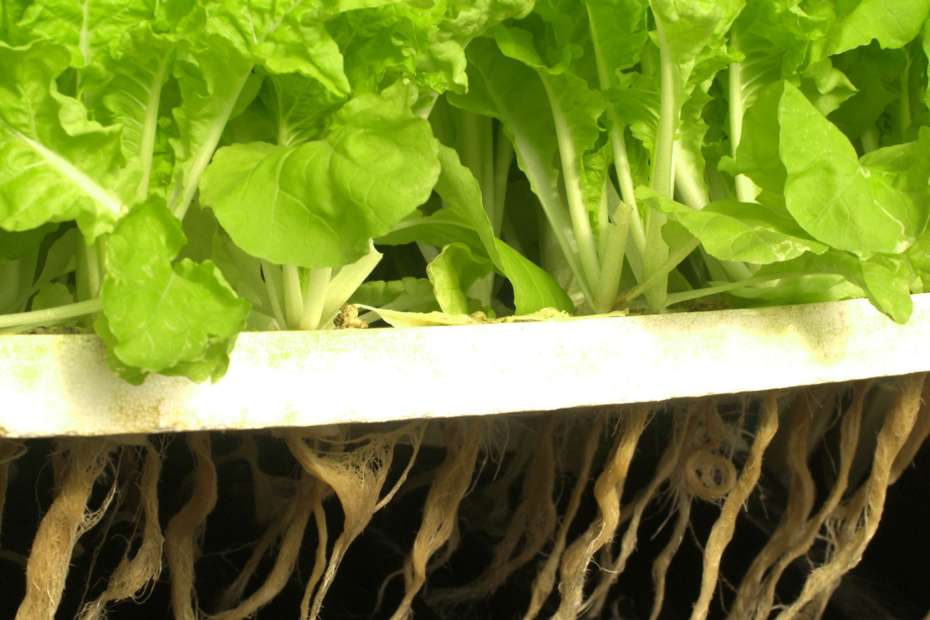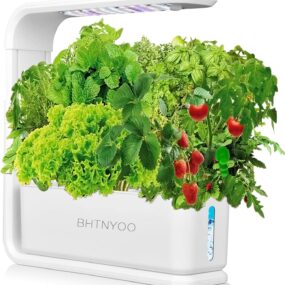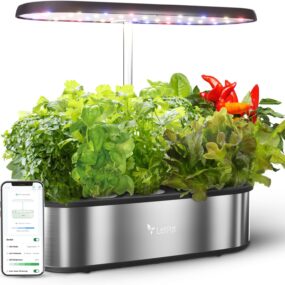Welcome to the world of indoor hydroponic gardening, where you can grow fresh and healthy produce right in the comfort of your home. With the rise in urban living and limited outdoor space, indoor hydroponic gardens have become a popular solution for those wanting to enjoy homegrown vegetables and herbs.
Using a soilless growing technique, hydroponics allows plants to grow in a nutrient-rich solution, providing optimal conditions for growth and maximizing yields. Whether you’re a seasoned gardener or a beginner with a green thumb, indoor hydroponic gardening offers a convenient and efficient way to grow a wide variety of plants all year round.
Imagine having a lush garden of vibrant greens, juicy tomatoes, and aromatic herbs flourishing in your living space, without the need for extensive gardening knowledge or constant watering and weeding. With indoor hydroponic systems, you can create an ideal environment where plants thrive, giving you a bountiful harvest of fresh and organic produce.
In this article, we will explore the benefits of indoor hydroponic gardening, different types of systems available, and how to set up your own indoor garden. Get ready to embark on a rewarding journey of growing your own food and bringing nature indoors.
Benefits of Indoor Hydroponic Gardening
Indoor hydroponic gardening offers a multitude of benefits that make it an attractive option for both seasoned gardeners and beginners alike.
Firstly, by eliminating the need for soil, indoor hydroponic systems reduce the risk of soil-borne diseases and pests. This allows you to grow your plants in a clean and controlled environment, ensuring healthy and thriving crops.
Secondly, hydroponics uses significantly less water compared to traditional soil gardening. The recirculating systems in hydroponics recycle the water, reducing water waste and making it an eco-friendly choice. This is particularly beneficial in regions with water scarcity or for individuals looking to minimize their environmental impact.
Additionally, indoor hydroponic gardening allows you to grow plants all year round, regardless of the weather conditions outside. With proper lighting and temperature control, you can create the perfect growing environment for your plants, providing them with the necessary light spectrum and warmth for optimal growth.
Furthermore, hydroponic systems can produce higher yields compared to traditional gardening methods. By delivering nutrients directly to the plants’ roots, they can grow faster and more efficiently, resulting in larger and more abundant harvests. This is especially advantageous for individuals with limited space, as you can grow a considerable amount of produce in a small area.
Lastly, indoor hydroponic gardening offers the convenience of having fresh and organic produce readily available in your own home. Imagine plucking a handful of fresh lettuce leaves or snipping aromatic herbs right before cooking a meal. With an indoor hydroponic garden, you can enjoy the satisfaction and health benefits of consuming homegrown food.
Types of Indoor Hydroponic Systems
When it comes to setting up an indoor hydroponic garden, there are several types of systems to choose from, each with its own advantages and considerations.
- Deep Water Culture (DWC): This is one of the simplest and most popular hydroponic systems for beginners. In a DWC system, plants are suspended in a nutrient-rich solution with their roots submerged in the water. Oxygen is provided through air stones or diffusers, ensuring the roots receive an adequate supply of oxygen. This system is ideal for growing leafy greens and herbs.
- Nutrient Film Technique (NFT): The NFT system involves a continuous flow of a thin film of nutrient solution over the roots of the plants. The roots are exposed to both the nutrient solution and air, allowing for efficient nutrient absorption and oxygenation. NFT systems are best suited for growing lightweight plants such as lettuce, spinach, and herbs.
- Ebb and Flow (Flood and Drain): In an ebb and flow system, plants are grown in pots or trays filled with an inert growing medium such as clay pellets or rockwool. The nutrient solution floods the growing area periodically, allowing the roots to absorb the nutrients. The excess solution then drains back into a reservoir. This system is versatile and can accommodate a wide range of plants.
- Aeroponics: Aeroponic systems mist the roots of the plants with a nutrient solution, providing them with both water and nutrients. The roots are suspended in the air, allowing for maximum oxygenation and nutrient absorption. Aeroponics is known for its ability to produce fast-growing and high-yielding crops, making it suitable for a variety of plants.
- Drip System: Drip systems deliver a nutrient solution to the plants through a network of drip lines. The solution is dripped onto the growing medium, allowing the roots to absorb the nutrients. Drip systems are flexible and can be used for a wide range of plants, making them a popular choice for indoor gardening enthusiasts.
Each system has its own advantages and considerations, so it’s important to choose one that suits your space, budget, and the plants you wish to grow. Consider factors such as the level of maintenance required, the availability of resources, and your gardening goals when selecting the right system for your indoor hydroponic garden.
Choosing the Right Plants for Your Indoor Hydroponic Garden
One of the exciting aspects of indoor hydroponic gardening is the wide variety of plants you can grow. From leafy greens and herbs to fruits and flowers, the possibilities are endless. However, it’s important to choose plants that are well-suited for indoor hydroponic environments to ensure successful growth.
Leafy greens such as lettuce, spinach, kale, and Swiss chard are excellent choices for beginners. They grow quickly and have relatively low nutrient requirements. Herbs like basil, parsley, mint, and cilantro are also popular choices due to their compact size and vibrant flavors.
If you’re looking to grow fruits, consider strawberries, tomatoes, peppers, and cucumbers. These plants require more space and specific lighting conditions, but with the right setup, you can enjoy the satisfaction of harvesting your own homegrown produce.
Flowering plants like orchids, roses, and orchids can also be grown hydroponically, adding beauty and fragrance to your indoor garden. However, they may require additional attention and specialized care.
When selecting plants for your indoor hydroponic garden, consider factors such as their light requirements, growth habits, and the amount of space they will occupy. Research the specific needs of each plant and ensure they are compatible with your chosen hydroponic system.
Setting Up Your Indoor Hydroponic Garden
Now that you have an idea of the benefits of indoor hydroponic gardening and the types of systems available, it’s time to set up your own indoor garden. Here are the steps to get you started:
- Choose a suitable location: Select a location in your home that receives ample natural light or where you can provide artificial lighting. Ensure the space is well-ventilated and has a stable temperature to create an optimal growing environment.
- Select a hydroponic system: Based on your space, budget, and the plants you wish to grow, choose the hydroponic system that best suits your needs. Consider factors such as maintenance requirements, resource availability, and your gardening goals.
- Gather the necessary equipment: Depending on the chosen system, you will need equipment such as grow lights, reservoirs, pumps, timers, pH meters, nutrient solutions, and growing mediums. Research and purchase high-quality equipment to ensure the success of your indoor garden.
- Prepare the growing area: Clean the chosen area and set up the hydroponic system according to the manufacturer’s instructions. Ensure all components are properly assembled and functioning before proceeding.
- Prepare the nutrient solution: Follow the instructions provided with your nutrient solution to mix it properly. Maintain the pH and nutrient levels within the recommended ranges for the plants you are growing.
- Plant the seeds or seedlings: Use a suitable growing medium such as rockwool cubes, coconut coir, or perlite for planting your seeds or transplanting seedlings. Place them in the hydroponic system, ensuring their roots are in direct contact with the nutrient solution or growing medium.
- Provide adequate lighting: If natural light is not sufficient, install grow lights to provide the necessary light spectrum for plant growth. Adjust the height and intensity of the lights according to the plant’s requirements.
- Monitor and adjust: Regularly monitor the pH and nutrient levels of the solution to ensure optimal plant health. Adjust these levels as needed and make any necessary changes to the lighting, temperature, and humidity to create an ideal growing environment.
- Maintain cleanliness: Keep the hydroponic system clean and free from debris or algae buildup. Regularly clean and sanitize the equipment to prevent the spread of diseases.
- Harvest and enjoy: Once your plants have reached maturity, harvest them by carefully removing the leaves or fruits. Enjoy the satisfaction of consuming fresh and organic produce right from your indoor hydroponic garden.
Setting up your own indoor hydroponic garden may require some initial effort and investment, but the rewards are well worth it. With proper care and attention, you can enjoy a continuous supply of fresh and nutritious produce all year round.
Nutrient Solutions for Indoor Hydroponic Gardening
In indoor hydroponic gardening, plants rely on nutrient solutions to receive the essential elements needed for growth and development. These nutrient solutions provide the necessary minerals and trace elements in the proper ratios, ensuring optimal plant health and productivity.
The composition of nutrient solutions varies depending on the plants being grown and the specific hydroponic system being used. However, there are several key nutrients that are essential for plant growth:
- Nitrogen (N): Nitrogen is crucial for leafy green growth and overall plant vigor. It is responsible for promoting lush foliage and healthy stems. Nitrogen deficiency can result in stunted growth and yellowing of leaves.
- Phosphorus (P): Phosphorus is essential for root development, flowering, and fruiting. It plays a vital role in energy transfer within the plant. Insufficient phosphorus can lead to poor root growth and reduced flowering and fruiting.
- Potassium (K): Potassium is involved in various plant processes, including water regulation, disease resistance, and enzyme activation. It promotes strong stems and helps plants withstand environmental stresses. Potassium deficiency can cause weak stems, leaf discoloration, and reduced fruit quality.
- Calcium (Ca): Calcium is necessary for cell wall development and the prevention of disorders such as blossom end rot in tomatoes and peppers. It also aids in nutrient uptake and overall plant structure.
- Magnesium (Mg): Magnesium is an essential component of chlorophyll, the pigment responsible for photosynthesis. It is vital for energy production and overall plant health. Magnesium deficiency can result in yellowing of leaves and reduced plant growth.
- Trace Elements: In addition to the macronutrients mentioned above, plants also require trace elements such as iron, manganese, zinc, copper, molybdenum, and boron in small amounts. These micronutrients play critical roles in various plant processes, including enzyme activation and photosynthesis.
To ensure the proper nutrient balance in your hydroponic system, it is important to follow the manufacturer’s instructions for mixing and maintaining nutrient solutions. Measure and adjust the pH and nutrient levels regularly to meet the specific requirements of the plants you are growing.
Maintaining Your Indoor Hydroponic Garden
To keep your indoor hydroponic garden thriving, regular maintenance is essential. Here are some key aspects to consider:
- Monitor pH and nutrient levels: Regularly test and adjust the pH and nutrient levels of the solution to ensure optimal plant health. Maintain the pH within the recommended range for your chosen plants, as pH fluctuations can affect nutrient availability and plant uptake.
- Check water and air circulation: Ensure the water in your hydroponic system is adequately oxygenated. Use air stones or diffusers to provide a constant supply of oxygen to the roots. Poor oxygenation can lead to root rot and plant stress.
- Inspect for pests and diseases: Regularly inspect your plants for signs of pests or diseases. Common pests in indoor hydroponic gardens include aphids, spider mites, and whiteflies. Treat any infestations promptly to prevent the spread and damage to your plants.
- Trim and prune: Regularly trim and prune your plants to maintain their shape and prevent overcrowding. This will improve air circulation and prevent the risk of diseases.
- Clean and sanitize: Keep your hydroponic system clean and free from debris or algae buildup. Regularly clean and sanitize the equipment to prevent the spread of diseases. Replace the nutrient solution periodically to maintain its quality.
- Adjust lighting and temperature: Monitor the lighting and temperature levels in your indoor garden. Adjust the height and intensity of the lights as needed to provide the optimal light spectrum for plant growth. Maintain a stable temperature range to avoid stress or damage to your plants.
By incorporating these maintenance practices into your routine, you can ensure the health and productivity of your indoor hydroponic garden for years to come.
Common Challenges and Troubleshooting Tips
Like any form of gardening, indoor hydroponic gardening comes with its own set of challenges. Here are some common issues you may encounter and tips to troubleshoot them:
- pH imbalance: If the pH of your nutrient solution is too high or too low, it can affect nutrient availability and plant uptake. Regularly test the pH and adjust it to the recommended range for your plants using pH-up or pH-down solutions.
- Nutrient deficiencies: Yellowing leaves or stunted growth can be signs of nutrient deficiencies. Check the nutrient levels in your solution and adjust as needed. Be mindful of the specific nutrient requirements of the plants you are growing.
- Root rot: Poor oxygenation or overwatering can lead to root rot. Ensure proper air circulation and avoid overwatering your plants. Consider adding beneficial bacteria or enzymes to the solution to promote healthy root development.
- Pest infestations: Inspect your plants regularly for signs of pests such as aphids, spider mites, or whiteflies. Use organic pest control methods or introduce beneficial insects like ladybugs to tackle the infestation.
- Lighting issues: Insufficient or improper lighting can affect plant growth. Ensure your plants are receiving the right amount of light and adjust the intensity and height of the lights accordingly. Consider investing in high-quality







